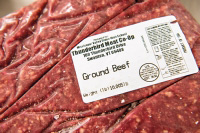Local Beef
September 01, 2015
When students at Missisquoi Valley Union Middle and High School bite into a juicy “Thunderbird” cheeseburger at lunchtime, they know exactly where the beef came from: their own campus.
 The school formed a co-op and obtained a license to sell meat. Its “Thunderbird Beef” is processed at a nearby USDA facility and sold back to the school’s lunch program. Photo by: Karen Pike
The school has started raising livestock on its grounds as part of a hands-on approach to agriculture education that was pioneered by the faculty. “We had a small, six-stall barn on campus,” recalled Richard Barwin, animal science instructor at the school. “We thought, how can we use this barn to grow the agriculture program and make it more production-oriented?”
The school formed a co-op and obtained a license to sell meat. Its “Thunderbird Beef” is processed at a nearby USDA facility and sold back to the school’s lunch program. Photo by: Karen Pike
The school has started raising livestock on its grounds as part of a hands-on approach to agriculture education that was pioneered by the faculty. “We had a small, six-stall barn on campus,” recalled Richard Barwin, animal science instructor at the school. “We thought, how can we use this barn to grow the agriculture program and make it more production-oriented?”
They didn’t have to look much further than the dairy farms that surround the school, which is located near the Canadian border in the heart of one of the largest dairy-producing regions in the United States. When dairy cows give birth to male calves, known as a bull calves, they are generally of little use to dairy farmers since they can’t produce milk. So the school struck a deal with a local organic dairy farmer to purchase four of his bull calves to raise for beef.
Acquiring the calves was an important step, but it would mean four hungry mouths to feed. That’s where Cargill came in. Cargill Feed & Nutrition Sales Manager Rick Button was visiting a longtime dairy customer when the owner’s daughter, who was a student at the school, approached him about supporting the project. Button took the idea to his local Cargill Cares Council, a group of employee volunteers, at the feed mill in Swanton, and Cargill agreed to donate 30-40 bags of feed to the program each month, enough to fulfill all of its feed requirements during the school year.
“When I look at Cargill’s purpose, we’re committed to nourishing people, and it’s great to be able to do that locally,” said Button, who has covered the same territory for 27 years. “It’s why we do what we do.”
The program launched in the fall of 2013. Students in grades 10 through 12 spent the school year raising the bull calves. In the summer months, when school was out, a teacher volunteered to help. “During the school year the kids do everything,” said Barwin, noting that less than half of his students have prior farming experience.
“They inoculate, castrate and tag the calves. They take great pride in feeding them and cleaning their stalls. It’s a very powerful experience. You can’t teach this stuff in a classroom.”
The school obtained a license to sell meat and formed a co-op in which the students are notional owners, learning the business side of raising beef cattle. In the fall of 2014, the first four cows were harvested at a nearby USDA processing facility. A group of students visited the plant to fully understand the process.
“It was a very professional, clean operation,” said Barwin. “I think the kids felt the process was as humane as it could be. We talked about animal welfare and had a good discussion.”
About 1,000 pounds of meat was sold back to the school for its lunch program, and another 450 pounds was sold to individuals. “Sort of like a bake sale, but with cuts of meat,” said Barwin.
Proceeds of all sales went back to the agriculture program. Now, whenever the lunchroom is serving the meat, staff makes sure the kids know by branding it as “Thunderbird” beef—the name of the school’s sports teams.
“It’s taken a long time to get where we are today,” said James Messier, chair of the school’s agriculture department and a relentless advocate for the program during his 49 years as a teacher there. “The whole thing relies on community support.”
“We have a tight budget, and our biggest expense is feed,” added Barwin, whose current class is raising five bull calves. “I can’t overstate how important Cargill’s support was to get the project off the ground.”
